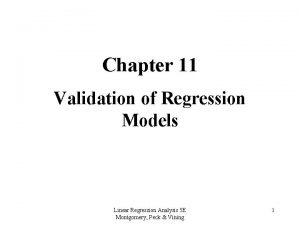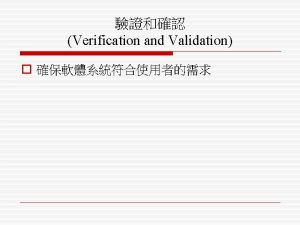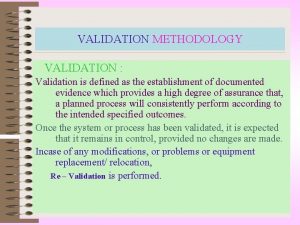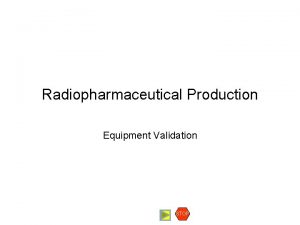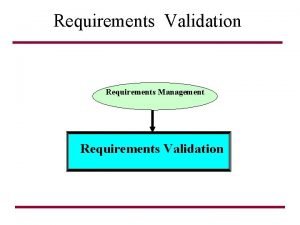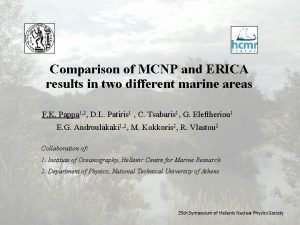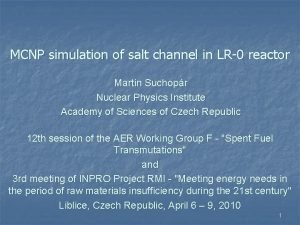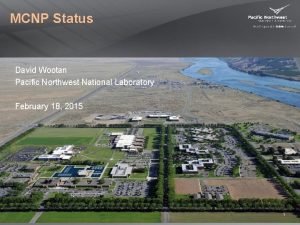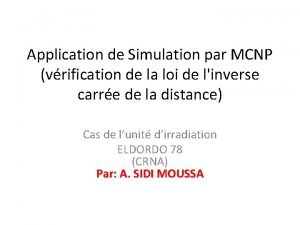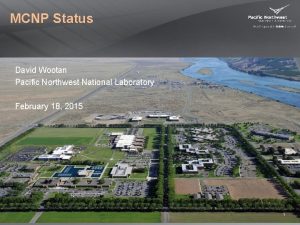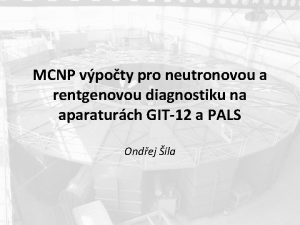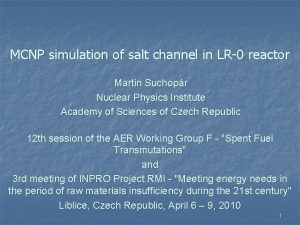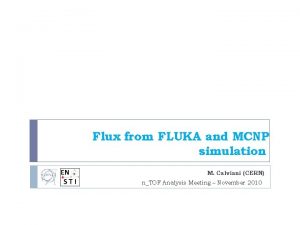Validation of the MCNP 5 Core model of






























- Slides: 30

Validation of the MCNP 5 Core model of the PSU Breazeale Research Reactor By C. Tippayakul, N. Kriangchaiporn, K. Ivanov, C. F. Sears, G. M. Morlang and B. J. Heidrich Department of Mechanical and Nuclear Engineering The Pennsylvania State University Monte Carlo 2005 Topical Meeting April 20 th, 2005

Outline l Introduction l Current PSBR Core loading model l Incorporation of fission product decay calculations l Validation against measurements l Conclusions l Future work

Introduction l What is the PSBR? l. A TRIGA mark III research reactor manufactured by General Atomic (GA) l Light water cooled and pool type reactor l Designed for 1 MW(t) steady-state operation and up to 2000 MW(t) when pulsing l Operating since 1965 (40 years old) when the core was upgraded from type MTR type fuel

Introduction The PSBR core

The PSBR core l Hexagonal uniform lattice l 20% enriched uranium l 2 types of fuel elements 8. 5 wt. % U-Zr. H mixture l 12. 0 wt. % U-Zr. H mixture l l 4 Control rods l 3 fuel follower rods (SA, SH, RR) l 1 air follower rod (TR)

The PSBR core PSBR current core

The PSBR core PSBR Fuel elements & Control rods

Current CL model l The MCNP 5 code is used to model the current PSBR core loading l Current l The PSBR core loading is CL-51 first task is to obtain the atomic number densities of each isotopes in each fuel element

Current CL model l It is very difficult to track burnup of each fuel element l Fortunately, burnup data from CL-48 was obtained by the experiment l Burnup data from CL-48 to CL-51 was obtained by HELIOS/ADMARC-H

Burnup data EOC CL-51

Atomic number densities determination l 2 D Burnup calculation by HELIOS for each fuel element Actinides + Fission products

Fission product decay l Unlike the power reactor, the PSBR is shut down daily l The buildup and decay of fission products occur in the fuel element during the reactor shutdown l Fission product decay analysis is needed to be performed

Fission product decay l First, decay of fission products of only one fuel element was studied l X 135 is the representation of fission product decays l The decay calculations were performed by ORIGEN 2. 2

Fission product decay l The fuel element was depleted at different average burnup power levels 200% 150% 100% 50% Fuel element no. 128

Fission product decay Amount of Xe 135 in the fuel element number 128 as a function of time after reactor shutdown depleted at different burnup power levels

Fission product decay l The amount of Xe 135 varies as a function of time l The time at which the amount of Xe 135 peaks depends on the power level l For the 100% nominal power level, the amount of Xe 135 at the shutdown time is smaller than that at the time within approximately first 10 hours after reactor shutdown

Fission product decay l The decay calculation of every fuel element was performed using 100% nominal power level l The atomic number densities of each fuel element at different times after the reactor shutdown were used in the MCNP 5 core model

PSBR CL-51 model l The Monte Carlo core calculations were performed Excess reactivity worth as a function of decay time

Comparison with current core analysis methodology l The MCNP 5 core model was compared against the current methodology l The current methodology utilizes HELIOS/ADMARC-H l The HELIOS is used to generate diffusion cross sections l The ADMARC-H is a 3 D nodal diffusion code

Comparison with current core analysis methodology l The 2 D HELIOS model was computed and compared to the 2 D MCNP model. l Criticality calculations were performed at several burnup steps l The atomic number densities between the two codes were consistent since HELIOS code was used to determine the atomic number densities for the MCNP 5 model

Comparison with current core analysis methodology l The HELIOS code utilizes multi-group cross sections derived from the ENDF-V data l The MCNP 5 utilizes continuous cross sections derived from ENDF-VI data (. 66 c where available)

Comparison with current core analysis methodology l MCNP VS. HELIOS Kinf comparison as a function burnup of the PSBR 2 D model

Comparison with current core analysis methodology l The full core calculation of the ADMARC-H was performed and compared to the MCNP 5 result

Comparison with current core analysis methodology RMS = 2. 72%

Validation against measurements l The MCNP 5 core model was validated against the experiment l The experiment was performed to measure the fuel element worth l The MCNP core model was calculated to determine the fuel element worth l Four elements were selected for the validation

Validation against measurements Experiment FW = CRW 2 – CRW 1 CRW 2 Calculation FW = Keff 1 Keff 2

Validation against measurements Fuel element worth comparison

Conclusions l The MCNP 5 core model of the current PSBR core loading was developed l The decay of fission products was accounted in the MCNP 5 core model l The agreement of excess reactivity with the experiment is good l The normalized pin powers of the MCNP 5 core model agree well with those of the ADMARC-H.

Conclusions l The MCNP 5 core model was validated with the experiment and the agreement is quite good l More validations with the experiment will be performed in the future

Future work l The MCNP 5 core model will be compared against the control worth obtained from the experiment l The MCNP 5 core model will be compared against the neutron flux obtained from the experiment
 Linear regression model validation techniques
Linear regression model validation techniques Validation plan
Validation plan Pricing model validation
Pricing model validation A nested model for visualization design and validation
A nested model for visualization design and validation Inner core and outer core
Inner core and outer core Inner core and outer core
Inner core and outer core Layers of earth from most dense to least dense
Layers of earth from most dense to least dense Core rigidities
Core rigidities Hình ảnh bộ gõ cơ thể búng tay
Hình ảnh bộ gõ cơ thể búng tay Lp html
Lp html Bổ thể
Bổ thể Tỉ lệ cơ thể trẻ em
Tỉ lệ cơ thể trẻ em Chó sói
Chó sói Thang điểm glasgow
Thang điểm glasgow Chúa yêu trần thế
Chúa yêu trần thế Môn thể thao bắt đầu bằng chữ f
Môn thể thao bắt đầu bằng chữ f Thế nào là hệ số cao nhất
Thế nào là hệ số cao nhất Các châu lục và đại dương trên thế giới
Các châu lục và đại dương trên thế giới Công của trọng lực
Công của trọng lực Trời xanh đây là của chúng ta thể thơ
Trời xanh đây là của chúng ta thể thơ Cách giải mật thư tọa độ
Cách giải mật thư tọa độ Làm thế nào để 102-1=99
Làm thế nào để 102-1=99 độ dài liên kết
độ dài liên kết Các châu lục và đại dương trên thế giới
Các châu lục và đại dương trên thế giới Thể thơ truyền thống
Thể thơ truyền thống Quá trình desamine hóa có thể tạo ra
Quá trình desamine hóa có thể tạo ra Một số thể thơ truyền thống
Một số thể thơ truyền thống Bàn tay mà dây bẩn
Bàn tay mà dây bẩn Vẽ hình chiếu vuông góc của vật thể sau
Vẽ hình chiếu vuông góc của vật thể sau Nguyên nhân của sự mỏi cơ sinh 8
Nguyên nhân của sự mỏi cơ sinh 8 đặc điểm cơ thể của người tối cổ
đặc điểm cơ thể của người tối cổ
